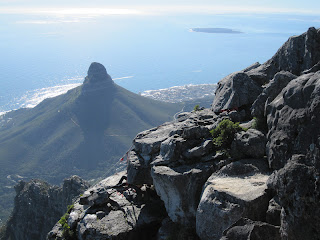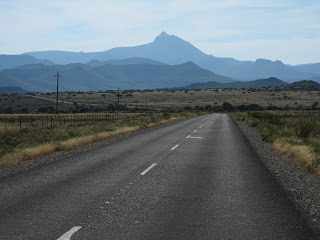Shauna & Pat's Excellent Adventure
Total Pageviews
27106
Tuesday, June 19, 2012
Post #10 - South Africa Part II
Hello S&P Bloggers,
We plan to write one more post
after this in an attempt to gain some closure on this truly insane year and a
half. However, this will take some serious reflection and therefore time, and
cannot say when it will be published. Keep checking back periodically, we don’t
want this to end!
With that said, this will be our last blog about new places
explored, and that is sad but exciting. Sad for the obvious reasons, exciting
because we are ready for the next chapter of our lives. We’ll go into that in
our farewell blog, so let’s get to this installment.
We begin in Cape Town, what must
be one of the most beautiful locations in the world for a major metropolis. The
area reminds us a lot of the California coast, except even more stunning. The
city itself has a very San Francisco look and feel. Suffice it to say, Cape
Town was a great place to kick back for five days and felt even more un-African
than the rest of South Africa. Even with all the beauty, we could not help but
feel the heavy and tragic past everywhere we went. This feeling was felt most
at the District Six museum in downtown Cape Town. The museum documents some of
the most brutal realities of Apartheid when the racist government forcibly
removed over sixty thousand people over a period of thirty years from the municipal
sixth district. Originally outside the official city limits, the area was a
vibrant mixed community of blue collar workers. As the city expanded and became
wealthier, the sixth district became prime real estate. The Group Areas Act of
1950 claimed the area for whites only, and the major relocation of non-whites
began. They were mostly moved to ghettoes in the far east of the city known as
the Cape Flats, and they still exist today. We drove around the Cape Flats
coming in and were shocked by their size and condition. They are just as bad as
other African ghettoes, and were a clear reminder of what continent we were in.
There are some bad places in America
to live - very bad in fact - but
nothing like these ghettoes. It’s amazing that wealthy Captonians can simply
drive by these hovels everyday as the people within their walls struggle to survive. It’s one reason the crime in
the country is so bad. A large majority of non-white people are extremely poor,
and they have the guns to rob and kill effectively. The African National
Congress (the ANC - Nelson Mandela’s party) set up a militant arm in their
fight for freedom, and the Soviets (among others) were all too willing to supply
arms and help bring down a capitalistic economy. Once the fight was over in the
early 1990s, there was a whole generation of poor black kids with a lot of
ammunition. With all the bad blood that Apartheid produced, it’s not hard to
understand why every house and business has an alarm system that comes with a
24-hour armed response team. The wrongs of the Apartheid regime are too many to
go into in this blog, but in short it is what happened in the American south in
the 1950s and 60s - but on steroids. It also lasted until the 90s, which seems
unbelievable now. It’s a brutal but fascinating tale, and we would encourage
everyone to do a little research if only to learn from yet another example of
what human beings are capable of.
Besides the museum, however, Cape
Town did not disappoint. Our hotel was fantastic and in the middle of the
action. The Grand Daddy Hotel was the center of social activity with its trendy
roof-top bar and second floor lounge that hosted salsa dancing on Friday
nights. They had these funky “hotel rooms”, seven in all, that were also on the
roof. What they really are is old trailers that have been converted into
certain themes. For example, there is one called “John and Yoko” which is
decked out with all sorts of Beatles memorabilia. The whole place had a hip
feel that was not too annoying. We loved it. We took the double-decker red bus
everywhere, one of the few times either of us had ever taken it. Cape Town is
an ideal city to use it, as neighborhoods are spread out and there are only a
few roads to take in any direction due to the mountains in every direction. We
could literally see the entire city in one giant loop. Using the bus we went to
Table Mountain, Cape Town’s most famous monument, even though it’s au naturale. We planned to hike it, but
wussed out and took the cable car instead. The views were incredible. We also
took the bus to Cape Town’s fashionable ocean side neighborhoods of Camps Bay
and Clifton. Here sit trendy bars, clubs and restaurants along with
multi-million dollar homes and condos along a perfect stretch of coastline.
Comparing Cape Town again to California, Camps Bay looks like a Rodeo Drive on
the water with a perfect beach. The only drawback (besides the amount of money
it would cost to live there) is the water temperature. It’s never high enough
to swim comfortably. The waves are great, though, and a surfer’s paradise as
long as you have a suit. Other fun experiences were the Neighborgoods Market
and the Good Food and Wine Expo. The Neighborgoods Market is a wonderful
gourmet market that takes place every Saturday, selling everything from fresh
food to upscale clothing to antique jewelry. We got a great day weather-wise
and it seemed like the whole white
city came out. We squeezed onto a long table and gorged on some fresh oysters,
followed by some cheese and champagne. Pat bought a shirt and we strolled in
and out of boutique after boutique. As for the Good Food and Wine Expo, we
simply stumbled into it one day walking by. It only happens once a year, and
Buddy Valastro from the Cake Boss was
this year’s keynote speaker. We didn’t see him, but we did enjoy walking around
tasting all the food and wine offered. In fact we enjoyed quite a bit of good food
and wine throughout our stay in Cape Town. There are an abundant amount of top
notch eateries serving an embarrassing amount of delicious wines. In many ways
the city is a global city.
Although we were reluctant to
give up our luxurious hotel room and Cape Town, we were excited for our last
three days in South Africa. From the city center we drove south along the coast
past the gorgeous Chapman’s Peak and onto Simon’s Town, home to South Africa’s
navy and one of three African Penguin populations on the continent. We casually
walked around the beach and took about a thousand pictures of the extremely
cute but endangered birds. They were yet another amazing animal we were lucky
enough to encounter and share a unique, wild experience that is very unlike a
zoo or aquarium. From the penguin colony we drove up False Bay and ended up
driving ninety-five percent of it. The only section we didn’t drive was the very
southern tip by the Cape of Good Hope, but we had seen so much of the gorgeous
coastline already we felt it was a little redundant. We were also antsy to
arrive at our final destination - the winelands. Not wine country or the vineyards,
the winelands lay pretty much in the triangle between Stellenbosch,
Franschhoek, and Paarl – about an hour northwest of Cape Town. Not to keep
harping about the natural beauty of the Cape Town area (and the country in
general), but the winelands of South Africa has to be the most beautiful great wine
producing area in the world. Granted we’ve only been to Napa and Sonoma, both
of which are gorgeous, but the winelands are truly spectacular. Along with the
scenery, of course, are hundreds of fantastic wineries, some hundreds of years old! The Dutch started
growing wine here not long after the first Cape colony was settled in the 1600s.
This was the case in Franschhoek (Afrikaans for French corner) as well, where
French Huguenots (Protestants) settled after fleeing the Catholic purges in
France. As we all know, the French know a thing or two about wine, and along
with Stellenbosch and Paarl, Franschhoek has become one of South Africa’s most
famous attractions. They even celebrate Bastille Day (beginning of French
Revolution – much like July 4th in America) every year! Along with
being one of the “big three” for wine, Franschhoek has become the unofficial
gastronomic capital of the country as well. It’s because of their food
reputation that we decided to base ourselves here. All three cities are within
a half hour’s drive of each other, but to have some of the country’s best
restaurants within walking distance of our B&B was a huge plus at the end
of the day. One night we splurged on what is consistently rated as one of the
top fifty restaurants in the world – The Tasting Room. The meal consisted on
five delicious courses, each paired with a wine. It was memorable. Between
meals and taking in the views, we tasted wine – a lot of it. Sometimes we did
all three at the same time. We visited six wineries in two days and hardly
scratched the surface of what we could
have done. All of the wine is cheap compared with California and most of it is just
as good. We got top quality pinotage for the equivalent of ten dollars! All in
all we couldn’t have imagined a better way for the two of us to finish off our
epic odyssey.
Before we knew it we had taken
the hour car ride to the airport, the two hour flight to Jo’burg, the sixteen
hour flight to New York, and the five hour cab/subway/train/car ride to
Saratoga. We were back in American suburbia wondering what the hell had just
happened. It was blurry, but Pat definitely remembers ordering two slices of
pizza across the street from Penn Station at 9am while we waited for our train
north. There was a lot of sensory overload - it was all so surreal. Within
twenty-four hours we were transported into another world, and it was hard to
fully understand. We’ve been back for almost three weeks now and things are slowly getting back to normal. We’ve
jumped right into all sorts of wedding stuff that needs to be done! We’ll
continue to do this and prepare for our future (starting in the fall) while trying
to adequately sum up the trip of a lifetime in our blog finale.
Until then,
S&P
Thursday, May 24, 2012
Subscribe to:
Posts (Atom)






























































































